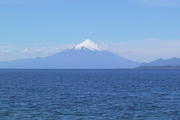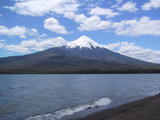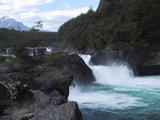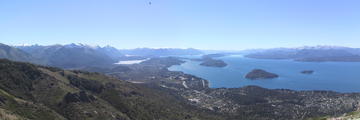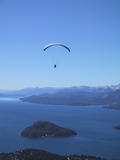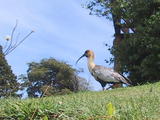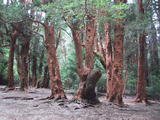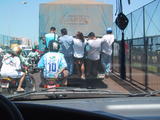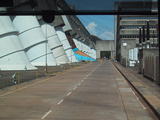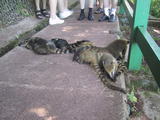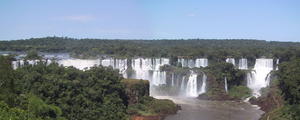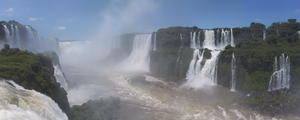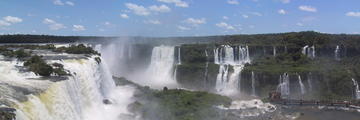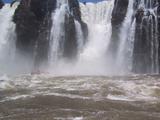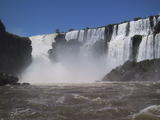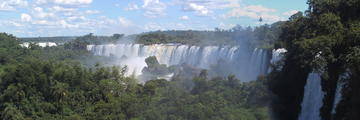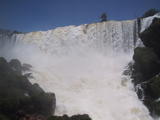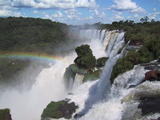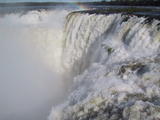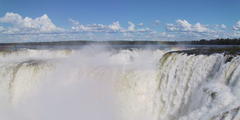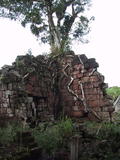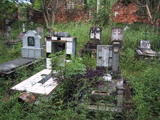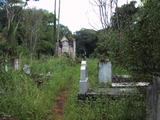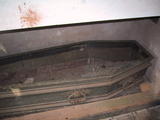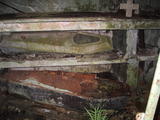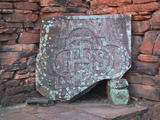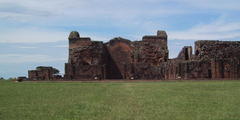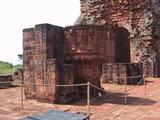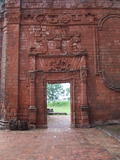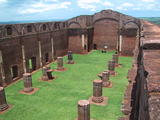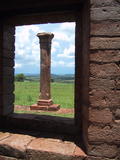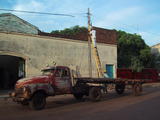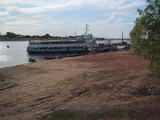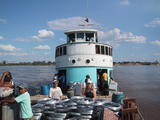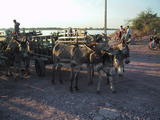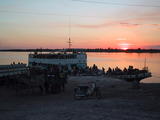| < < < Previous story | Next story > > > | |
Iguazu, Jesuit Mission ruins and the river ParaguayItamaracá & Holland, 4 & 12 March 2004
Contents:Puerto VarasWe have just flown back to Holland from Brazil, with a stopover in Madrid on March 10th, the day before those cowardly terrorist attacks that killed 200 innocent civilians. The previous update ended with us getting off the Navimag ferry that took us from Puerto Natales to Puerto Montt in Chile. Since then we have traveled some more through Argentina but also through Paraguay and Brazil, but I will leave most of Brazil for the next update, because this update would otherwise become too long. As we had already booked a flight from Bariloche to Buenos Aires and from Buenos Aires to Iguazu, we had 6 days left to explore the Puerto Montt and Bariloche area upon getting off the ferry. We decided to spend 2 days in Puerto Varas, 3 days in Bariloche and 1 day traveling from Puerto Varas to Bariloche. We had heard that is was possible to travel the lake route taking busses between the lakes and boats on each lake to get to Bariloche, but this is an expensive option as the land straddling the border is privately owned and they charge 70 to 80 USD for the privilege to pass through their land! This seemed somewhat over the top, so we opted instead to see the lakes on each side of the border but cross the border by taking the regular bus from Puerto Varas to Bariloche. Puerto Varas was originally a German town, it still has a distinct feel with its German architecture. From Puerto Varas, the near perfect cone of the Osorno volcano was clearly visible. We day tripped to lago Todos los Santos, a very picturesque mountain lake, at the foot of the volcano. The nearby waterfalls on the Petrohue river seemed to lack water but you could still imagine what they would look like with more water. The majestic Osorno volcano in the background completed the picture. As we left Chile for the second time, we talked with some fellow passengers while waiting for the lengthy border procedures to complete. A Chilean was complaining about poverty in his country yet he was going on vacation in Argentina because it was so much cheaper (and poorer). Comparing Chile to other South American countries we could only conclude that it was by far the richest. For travelers it is also by far the most expensive. The Chilean Peso is also a very strong currency. All over Chile prices that used to be indicated in both Chilean Pesos and US Dollars are now only in Pesos, the Dollar amounts have been erased, because the Peso did not drop along with the Dollar. On one occasion someone actually refused to accept US Dollars even at the lower exchange rate because he said "what will they be worth when I get back to town to change them?" Chile appears to be a very successful country especially by South American standards. It is good to see that at least one country has been able to avoid financial and economic collapse, it proves that it is possible, even in South America to create an economic success story. One can only hope that their neighbors might learn something from them. BarilocheOur next stop, Bariloche, is a mountain resort town on the shores of a lake in the Andes. When we arrived at the bus terminal an English speaking woman with a Dutch accent offered us accommodation in her hostel. We asked where she was from and our suspicions were confirmed. We decided to stay at her hostel. She had been running it for several years, though, originally she had moved to Argentina to live with her Argentinian husband from whom she is now divorced. But she wanted to stay she said, because she could not live in Holland anymore. Something I can understand very well. In Bariloche there is a mountain bearing my name: Cerro Otto! A ski lift brings you to the top. We did not have enough time to do any serious hiking in the area but explored the area around Llao-llao a bit. Bariloche and the surrounding area would be much better visited if you had a week or two to spend there. As unbelievable as it might seem, we simply do not have enough time! Bariloche is also renowned for its chocolate, some of which is truly delicious. Our attempt to visit a chocolate factory failed because they were not working that day apparently because it was too hot! Unfortunately it was our last day in Bariloche. IguazuWe had arranged to meet our friends Sam and Nadia in Buenos Aires and fly together with them to Iguazu. We could not pass through Buenos Aires again without eating at our favorite steakhouse, la Chacra! The flight to Iguazu was with Southern Winds on an e-ticket we had purchased online. Confusingly they use the $ sign when quoting prices on their website, but as that sign is used everywhere in Argentina to indicate Pesos, while they use us$ or illogically u$s for US Dollars, we assumed, as it turned out correctly, that the prices on the website were in Pesos. That is about a factor 3 difference! Upon arriving in Iguazu we booked several good bargains for hotels through an office at the airport. By chance we first stayed three nights on the Brazilian side followed by one on the Argentinian side. Surprisingly enough border procedures are voluntary: upon entering Brazil the driver asked us if we wanted to go through Brazilian immigration, but this was only necessary if we wanted to travel further into Brazil. We said no, as we were going to return to Argentina first, so he did not even bother to stop! We did not spend our first day at the falls, but visited Ciudad del Este in Paraguay instead, crossing another border without any form of control. The bridge linking the two countries has a permanent traffic jam, though it moves enough to entice pedestrians to hang on to the back of trucks! Ciudad del Este is one big market, including lots of electronics shops, but without bargaining skills you will soon pay more than in an overtaxed shop in Europe. Our second outing of the day was a visit to the Itaipu dam, the largest in the world, at least before the Three Gorges in China was built. But, they claim that, even the Three Gorges hydroelectric power plant will not be able to produce as much electricity per year as Itaipu. Itaipu is located on the Paraná river straddling the Brazil-Paraguay border. The hydroelectric power plant supplies 25% of Brazil's electricity and 95% of Paraguay's! The free tour of the dam included the screening of a propaganda film on the dam and Brazil, during which we saw a radiant Lula da Silva, the president of Brazil, say that the construction of the dam proved that Brazil was not a 3rd world country but a 1st world country. The dam was built destroying the island of Itaipu after which the dam has been named. In Guarani, the local Indian language, it supposedly means "island of the singing rocks", so called due to a sound made by the rocks when water fell on them. Furthermore what is said to have been the world's most voluminous waterfall, Sete Quedas, with 30 times more water than the Iguassu falls is now submerged by the artificial lake caused by the dam. The dam also contributed heavily to inflate Brazil's foreign debt. Finding the balance between economic development on one side and the environmental and financial costs on the other is particularly difficult, a government must weigh all advantages and disadvantages. It also has a particular duty to its citizens: to facilitate their medium and long term prosperity. Even though my initial reaction was quite critical, I felt that I would rather have seen the world's most voluminous waterfall than a giant dam, I cannot pretend to know enough of the facts or be certain that I would have made a different decision after weighing the pros and cons. On the second day we visited the Iguassu falls on the Brazilian side. From this side you get the overview of the area, allowing you the grasp the extent of the falls. Early in the morning of the 3rd day we returned to Argentina, again skipping Brazilian border procedures, though the Argentinians insisted on giving us yet another Argentinian entry stamp, our fourth. We continued on to see the falls from the Argentinian side. We started with a boat tour that took us literally under the waterfall, making everybody and everything soaking wet. On the Argentinian side you really do get much closer to the falls, not only because you can be soaked by them, but because there are a great many tracks to follow that bring you close to many of the waterfalls. The last track ends with a spectacular view over Devil's Throat. We floated back down river above the falls in a rubber boat seeing the water fall down maybe just 100 meters from us. During this excursion we got to see 2 toucans in the wild for the first time. The park entry fee on the Argentinian side was different for a whole set of categories, foreigners paying most, Mercosur citizens less and Argentinians even less. But I saw that entry for the handicapped was free, so I asked if this was also valid for foreigners and if missing a foot counted. It did. I can't remember ever getting a discount on this basis, let alone a 100% discount. Another person, who shall remain nameless, successfully passed herself off as Argentinian. Discussing what we had seen, we considered that we had visited everything in the correct order, slowly building up to a climax at the end. So our advice to others would be, first visit the Brazilian side of the falls, to get the overview, only then visit the Argentinian side, where you should see the Devil's Throat last. The second point of interest is that we all had high expectations of the falls. High expectations often lead to disappointments because those expectations are not met. In the case of Iguazu our expectations were greatly surpassed. After our 4th night, this time in Puerto Iguazu, Sam and Nadia had to fly back to Buenos Aires and we took the bus to San Ignacio. Jesuit Mission RuinsSan Ignacio is a small town built around the ruins of the best restored Jesuit Mission. Anyone who has seen the movie "The Mission" knows what happened here. These missions were set up in order to protect the indigenous Guarani from Portuguese slavers in Brazil and convert them to Catholicism at the same time. As the king of Spain feared that the Jesuits wanted to set up their own state, he ordered the Jesuits to be expulsed from Spanish territories. Subsequently the missions decayed or were attacked and destroyed. Santa Ana, another mission in ruins near San Ignacio has less ruins to show, but has the added benefit of hosting a creepy graveyard that was used well into the 20th century. In family graves, coffins have fallen and opened. Graves are overgrown with vegetation. All this in the middle of the jungle. Just as we did, I advise a visit on an overcast day just before sunset for maximum effect! Not yet knowing how much we would miss Argentina, we left the country, for the fourth time, by crossing the Posadas to Encarnación bridge into Paraguay. We got a room in the "best" hotel in Encarnación, which was OK, but food was not what we had grown accustomed to in Argentina. We visited two other Jesuit missions in Paraguay, Trinidad and Jesus. In Jesus you can still climb a tower of the church. Up the Paraguay RiverWhile reading the Lonely Planet guide we found out about a possible river trip from Paraguay to Brazil via the Paraguay river, so we decided to head to Asunción to find out more, but the only thing we found out is that there was a boat from Concepción to Bahia Negra, whether it was possible to cross into Brazil was unclear and further information was probably available at the port in Concepción. We tried to fly to Concepción, but all flights in Paraguay, except for the Asunción to Ciudad del Este route, had been suspended due to a lack of customers (this sounds like a pretty good reason to me). So we had to spend another day in a bus. Asunción seemed rather unsafe, one night while we were eating out, we saw the street outside slowly change into a red-light district, so we took a cab instead of walking the 8 blocks to the hostel. Concepción on the other hand seemed a lot safer, but was also pretty dead, nothing much seems to happen there since it is a small town. Again we checked into one of the "best" hotels. It was pretty OK, it even had a pool. While trying to arrange the boat trip we met two other travelers, Diederik from Holland and Jens from Denmark, who were also trying to get to Brazil via the river. We were too late to secure a "room" on the boat, but were assured that we could sleep on benches. Nobody knew anything about border procedures either, only that we could get off in Isla Marguerita and cross the river into Porto Murtinho, Brazil. So we left Concepción on the boat called the Aquidaban on a Tuesday morning. Obviously the locals knew the boat well so we were the only ones without mattresses, covers and benches to sleep on, as someone else would occupy the whole bench as soon as you left. The first night we managed to re-conquer a bench, but the second we just slept on the hard surface of the deck in our dirty clothes, watching the stars as we fell asleep. I had attempted to find the life vests, for the purpose of having something softer to sleep on, but could not find any. Nobody else had life vests either so we figured that they did not exist. The riverboat is like a local bus, stopping at every settlement on the riverbanks, day and night. Spending 2 days on the boat we had an opportunity to talk with other passengers, Indians returning to their villages, families visiting relatives, a Spanish lady working on a project to help a Indian village in a remote area. An intriguing story was that of a young girl returning home to her grandmother after having run away to look for her mother who had left to work in Asunción. An acquaintance found her wondering through the streets in Concepción, she never reached Asunción, and took her on the boat back to her grandmother. Entering BrazilWe arrived on Isla Marguerita at 03:00 on Thursday. We crossed the river into Brazil, using the services of man with a little rowing boat, it felt like sneaking into the country. With no border guard in sight we decided to search for the federal police station, who, we were told by the Brazilian consulate in Concepción would issue us our entry stamps (no visas required for our nationalities). Unfortunately we only found the military police station, manned by one sleeping soldier. We woke him up saying: "Hello, we are foreigners and have just entered your country. We need to get entry stamps." Clearly the guy was in no mood to do any work and sent us off to the border town of Bela Vista, were, he assured us, we could go through immigration procedures. Fortunately there was a bus at 05:00. Several hours later we took a taxi from the bus terminal to the border crossing at Bela Vista. Since we had not gotten a Paraguayan exit stamp either we went to get that stamp first. The immigration official was amazed to see us enter from Brazil and ask for a Paraguayan exit stamp! "Crazy foreigners", he must have thought, "but if that's what they want, why not?" We subsequently drove on into Paraguay in plain view of the border guard who had just given us the exit stamp to an exchange office to exchange some leftover Guaranis. Things weren't making any sense anymore anyway. Upon returning to Brazil, this time not stopping for Paraguayan immigration we searched in vain for a Brazilian official to stamp our passports. Now we were told to go to Campo Grande and assured that there was a federal police station there. As Campo Grande is the capital of the state of Mato Grosso do Sul, even though several hundreds of kilometers from the border, we thought this might be correct. We were also running out of cash as we had not found a working ATM since Asunción. Campo Grande might be the place to solve this problem as well. We arrived in Campo Grande late in the evening, so we could only get to the federal police station the next morning. An attractive, young and smiling female immigration official sensually stamped our passports! I would not have minded to be fingerprinted by her, but that privilege was reserved for US citizens! When we left Brazil we discovered she had stamped us in one month earlier than we had actually arrived, but this did not lead to any problems! The rest of our Brazil experience, including carnival in Salvador, is for the next update. If you would like to be notified when we write more about our trip, just send us an E-mail. e-mail Otto de Voogd PhotosPuerto VarasBarilocheIguazu/IguassuJesuit Mission RuinsAquidabanPractical Information
To my knowledge the information provided here was accurate
at the time of our visit. However time passes and things can change.
Transportation
Money(ATMs for Maestro/Cirrus bankcards)
Chile: All ATMs
CostsChile - Pesos, approx. rates: 1 USD = 560 CLP, 1 EUR = 715 CLP Puerto Varas - Hospedaje Elsa : 10,000 CLP shared bathroom Argentina - Pesos, approx. rates: 1 USD = 2.90 ARS, 1 EUR = 3.60 ARS
Bariloche - Hostel Aventura: 34 ARS per room, shared bathroom, Dutch owner.
Brazil - Reais, approx. rates: 1 USD = 2.95 BRL, 1 EUR = 3.67 BRL
These two hotels were arranged and paid upon arrival at the airport
in Argentina and therefore paid in Argentinian pesos:
Argentina - (for exchange rates see above)
Puerto Iguazu - Hotel Alexander: 70 ARS.
Paraguay - Paraguayan Guaranis, approx. rates: 1 USD = 6000 PYG, 1 EUR = 7500 PYG
Encarnación - Hotel Cristal, aircon, priv. bath: 95.000 PYG
Brazil - (for exchange rates see above) Campo Grande - Hotel Colonial: 52 BRL aircon, priv.bath, cable-TV, great breakfast! | ||
| < < < Previous story | Next story > > > | |
New | About | Contact | Connect | Friends | Promotions | Copyright | Advertise
